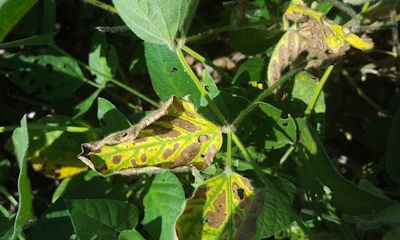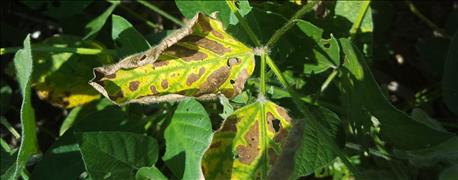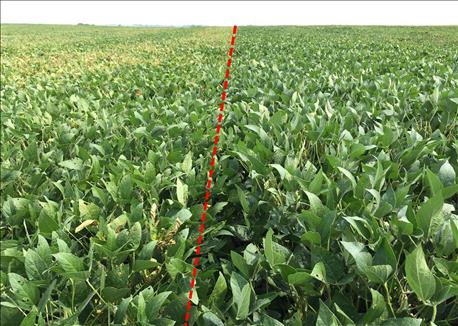April 9, 2016

As Nebraska farmers prepare for soybean planting, they have a new option for controlling sudden death syndrome (SDS).
The disease is caused by the soil borne fungus Fusarium virguliforme. Sudden death syndrome was first observed in Nebraska in 2004 in Nemaha and Pierce counties in eastern Nebraska. While this is a relatively new disease for Nebraska soybean farmers, there are several locations in the state where significant percentages of fields have been affected.
The disease is favored in high-yield environments and is more prevalent during cool, wet growing seasons. Fields that have soybean cyst nematode (SCN) have a greater likelihood of having more severe SDS.

Figure 1. Sudden death syndrome foliar symptoms on soybean leaves at the Ulysses on-farm research location.
Soybean growers were encouraged to adjust their management by selecting varieties with moderate-to-high levels of resistance to SDS and avoid early planting in fields known to be severely affected by SDS. However, previous research has shown that for each day planting is delayed after May 1, 0.25 to 0.625 bushels per acre of yield can be lost, making delayed planting a less than optimal management practice.
Research protocol
In 2015, three farmers working with the Nebraska On-Farm Research Network evaluated ILeVO, a Bayer Crop Science seed treatment to determine if the treatment provided additional benefit beyond that provided by variety selection and if it provided adequate control of SDS in early planted soybeans.
Soybean varieties with good resistance to SDS were selected for this study. The impact of variety selection can be seen in Figure 2. Varieties used in this study were comparable to the more resistant variety shown on the right in Figure 2.

Figure 2. Two soybean varieties in Dodge County, 2015, with varied SDS resistance. The variety on the right is a more resistant variety.
The farmers in this study were also encouraged to not delay planting if possible; however, wet weather proved challenging. The study sites were sampled for SCN to establish the base infestation level for the trial. Site information is shown in Table 1.
Table 1. Soil type, SCN populations, variety, and planting and harvest dates for three on-farm research sites located in eastern Nebraska evaluating ILeVO seed treatment for controlling sudden death syndrome. | |||||
|---|---|---|---|---|---|
SITE | SOIL TEXTURE | AVERAGE SCN POPULATION | VARIETY | PLANTING DATE | HARVEST DATE |
Fremont | Silty clay loam | 1,117 (medium) | Asgrow 2834 | 5/21/15 | 10/6/15 |
Scribner | Silty clay loam | 33 (low) | Hoegemeyer 2860 NRR | 5/21/15 | 10/6/15 |
Ulysses | Silt loam | 247 (low) | Asgrow 2733 | 5/29/15 | 10/2/15 |
~~~PAGE_BREAK_HERE~~~
Three treatments were evaluated at sites that had SDS the last year when soybeans were grown (2013), including non-treated soybean seed, standard soybean seed treatment, and a standard soybean seed treatment plus ILeVO, used at the high rate for SDS.

Figure 3. Sudden death syndrome disease index scores for non-treated soybean seed, standard treated seed, and standard plus ILeVO treated seed at three locations in eastern Nebraska. (Bars with same letters indicate values are not significantly different at a 90% confidence level. Letters apply within a site.)

Figure 4. Soybean yield (bushels per acre) for non-treated soybean seed, standard treated seed, and standard plus ILeVO treated seed at three locations in eastern Nebraska. (Yield values reported here are from weigh wagon data. Bars with same letters indicate values are not significantly different at a 90% confidence level. Letters apply within a site.)
Foliar disease symptoms were assessed using an SDS scoring method developed by Southern Illinois University at Carbondale. Disease severity was assessed using a 1 to 9 scoring system with a score of 1 indicating the fewest symptoms and 9 indicating premature death. Disease incidence of affected plants was determined by observing the percentage of plants with leaf symptoms. These metrics were combined to create the disease index (DX).
The Scribner site had a very low disease index and there was no difference between the three seed treatments, while the other two sites saw a lower disease index for the ILeVO treatment.
There was a significant yield increase (Figure 4) for the ILeVO treatment as compared to the standard seed treatment at the Ulysses and Fremont sites. (Ulysses had a 2 bushel per acre yield increase; Fremont had a 7 bushel per acre yield increase.) The Scribner site, which had a very low disease index and low SCN numbers, did not see a yield response for the ILeVO treatment. Because SDS occurs in pockets throughout a field, it's difficult to establish a disease threshold of when to use ILeVO in order to justify the added costs.
Source: UNL CropWatch
You May Also Like




